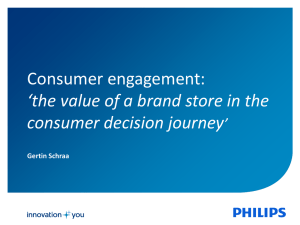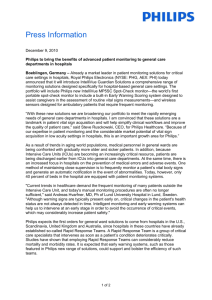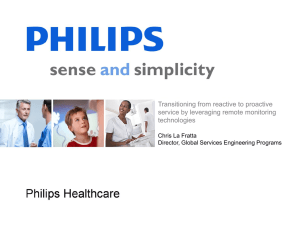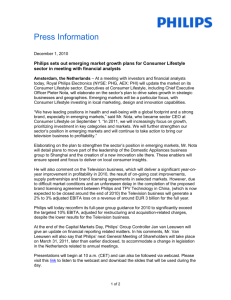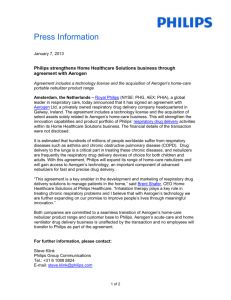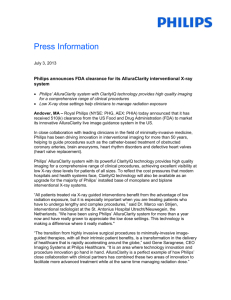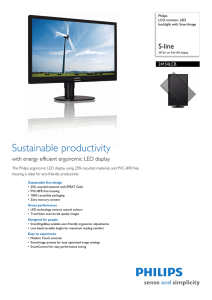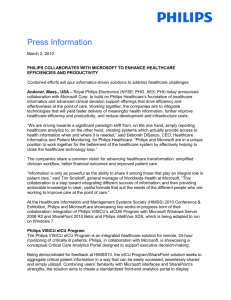Press Information
advertisement
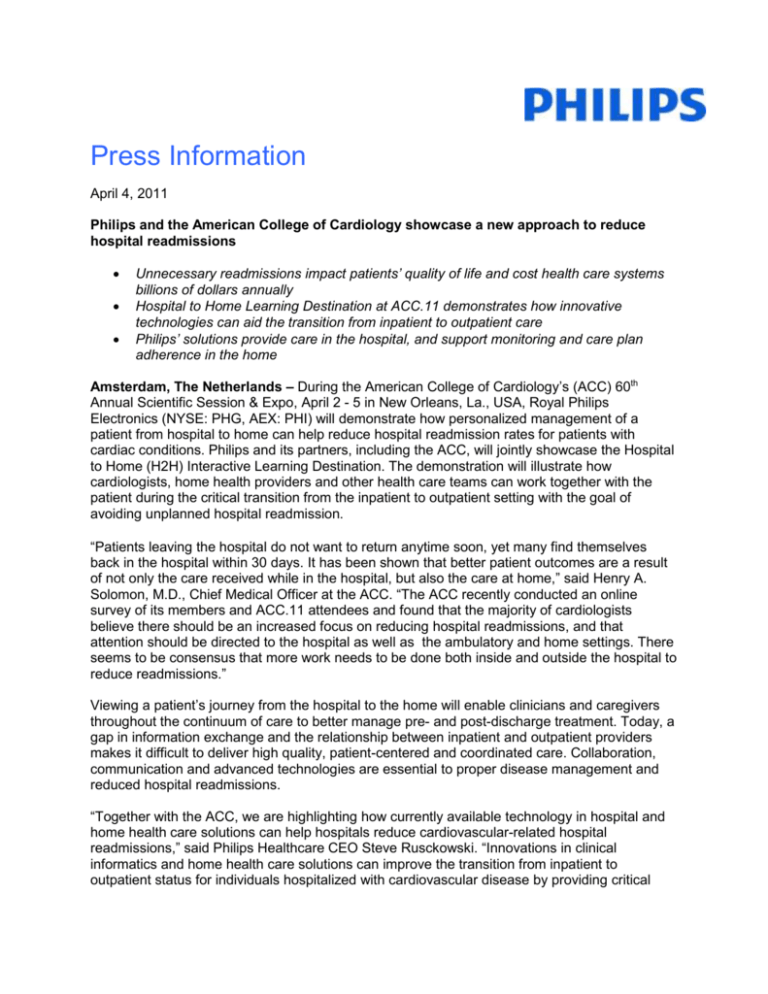
Press Information April 4, 2011 Philips and the American College of Cardiology showcase a new approach to reduce hospital readmissions Unnecessary readmissions impact patients’ quality of life and cost health care systems billions of dollars annually Hospital to Home Learning Destination at ACC.11 demonstrates how innovative technologies can aid the transition from inpatient to outpatient care Philips’ solutions provide care in the hospital, and support monitoring and care plan adherence in the home Amsterdam, The Netherlands – During the American College of Cardiology’s (ACC) 60th Annual Scientific Session & Expo, April 2 - 5 in New Orleans, La., USA, Royal Philips Electronics (NYSE: PHG, AEX: PHI) will demonstrate how personalized management of a patient from hospital to home can help reduce hospital readmission rates for patients with cardiac conditions. Philips and its partners, including the ACC, will jointly showcase the Hospital to Home (H2H) Interactive Learning Destination. The demonstration will illustrate how cardiologists, home health providers and other health care teams can work together with the patient during the critical transition from the inpatient to outpatient setting with the goal of avoiding unplanned hospital readmission. “Patients leaving the hospital do not want to return anytime soon, yet many find themselves back in the hospital within 30 days. It has been shown that better patient outcomes are a result of not only the care received while in the hospital, but also the care at home,” said Henry A. Solomon, M.D., Chief Medical Officer at the ACC. “The ACC recently conducted an online survey of its members and ACC.11 attendees and found that the majority of cardiologists believe there should be an increased focus on reducing hospital readmissions, and that attention should be directed to the hospital as well as the ambulatory and home settings. There seems to be consensus that more work needs to be done both inside and outside the hospital to reduce readmissions.” Viewing a patient’s journey from the hospital to the home will enable clinicians and caregivers throughout the continuum of care to better manage pre- and post-discharge treatment. Today, a gap in information exchange and the relationship between inpatient and outpatient providers makes it difficult to deliver high quality, patient-centered and coordinated care. Collaboration, communication and advanced technologies are essential to proper disease management and reduced hospital readmissions. “Together with the ACC, we are highlighting how currently available technology in hospital and home health care solutions can help hospitals reduce cardiovascular-related hospital readmissions,” said Philips Healthcare CEO Steve Rusckowski. “Innovations in clinical informatics and home health care solutions can improve the transition from inpatient to outpatient status for individuals hospitalized with cardiovascular disease by providing critical support throughout the patient’s journey – whether by providing clinical decision support to clinicians, better education and information to patients, or ongoing surveillance of chronic illness in the home.” Readmission management is gaining importance not only because it benefits patients’ health and well-being, but also because it has significant financial repercussions on health care systems. A 2009 study in the New England Journal of Medicine analyzed patterns of rehospitalization of Medicare beneficiaries in the United States over a two year period and found that almost one-fifth of the nearly 12 million Medicare beneficiaries who had been discharged from a hospital were rehospitalized within 30 days. The study’s authors estimated that the cost to Medicare of unplanned rehospitalizations in just one of those years was $17.4 billion.1 As a part of health care reform in the United States, Medicare is addressing this problem by enacting financial penalties on hospitals with higher than expected readmissions within 30 days after a hospital admission for heart failure, heart attack or pneumonia. At ACC.11, Philips will feature an interactive and educational showcase of three cardiac patients’ journeys. Each patient has had a different cardiac disease or event, with different experiences with respect to diagnosis, treatment and monitoring in the hospital, as well as a unique discharge plan and options for post-discharge care and monitoring for comorbidities, such as sleep apnea or heart arrhythmia. Within the exhibit, attendees will walk through simulated hospital and home environments, which will include hands-on demonstrations and patient testimonials. These demonstrations will show best practices for reducing hospital readmissions and improving patient quality of life post-discharge. The adjoining H2H theater will feature clinically-based presentations from leaders in the field, as well as discussions with physicians and health care providers who currently utilize hospital and home-based services. Please find additional information on new products showcased at ACC.11 by visiting the Philips Healthcare booth at Hall D, #3329 and the Hospital to Home Interactive Learning Destination at Hall D, #3347. Information can also be accessed online at http://www.philips.com/media. For media inquiries, please contact: Steve Klink Philips Corporate Communications Tel: +31 6 10888824 E-mail: steve.klink@philips.com Ian Race Philips Healthcare Tel: +1 (978) 659-4624 E-mail: ian.race@philips.com 1 Stephen F. Jencks, M.D., M.P.H., Mark V. Williams, M.D., and Eric A. Coleman, M.D., M.P.H., “Rehospitalizations among Patients in the Medicare Fee-for-Service Program,” The New England Journal of Medicine, 2009; 360:1418-28. About Royal Philips Electronics Royal Philips Electronics of the Netherlands (NYSE: PHG, AEX: PHI) is a diversified health and well-being company, focused on improving people’s lives through timely innovations. As a world leader in healthcare, lifestyle and lighting, Philips integrates technologies and design into people-centric solutions, based on fundamental customer insights and the brand promise of “sense and simplicity”. Headquartered in the Netherlands, Philips employs 119,000 employees in more than 60 countries worldwide. With sales of EUR 25.4 billion in 2010, the company is a market leader in cardiac care, acute care and home healthcare, energy efficient lighting solutions and new lighting applications, as well as lifestyle products for personal well-being and pleasure with strong leadership positions in flat TV, male shaving and grooming, portable entertainment and oral healthcare. News from Philips is located at www.philips.com/newscenter.
